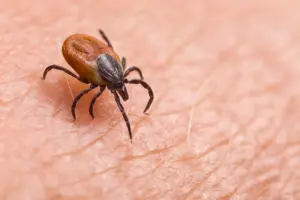What to do before you go outside

Getty Images
Each of these steps adds an extra layer of protection and can help you enjoy the outdoors safely:
- Use tick repellents
- Tick-proof clothing and gear
- Dress for tick safety
- Bring tick-ready supplies with you
Use tick repellents
Different types of repellents can help protect you against tick bites.
The three main choices of repellents are:
- DEET
- picaridin
- natural repellents
DEET and picaridin are more effective than natural repellents. Most repellents come in many forms such as spray, lotion, and towelette. Many have a pleasant smell, are not sticky, and are easy to apply.
Some repellents are registered by the Environmental Protection Agency (EPA). EPA-registered repellents have been evaluated and deemed safe and effective when applied according to instructions on the label.

Getty Images

EPA
Which bugs does it repel?
Check the label of a repellent to see if it has the EPA Repellency Awareness Graphic. This tells you which bugs the product repels, and for how long.
How to apply repellent
Always follow correct use instructions on the package. In addition, follow these general rules:
- If you are also using sunscreen, apply that first and then apply repellent.
- Apply repellent outdoors or in open areas to avoid breathing it in.
- Apply repellent to all exposed skin. You can also spray it on your clothing, but another product called permethrin is more effective for keeping ticks off of clothing.
- Do not apply repellents under clothing.
- Use just enough repellent to lightly cover but not soak your skin.
- Try not to get repellent into your eyes and mouth.
- If using a spray repellent, remember to spray your head, too, but be sure to avoid your face. Spray repellent on your hands, then gently rub it onto your face.
- If using a spray repellent, rub your skin after you apply it to make sure the repellent spreads across all exposed areas (similar to applying lotion).
- Do not apply repellent to cuts, wounds, or broken skin.
- Some repellents are flammable, so do not apply them near open flames.
- Help children to apply repellent, and do not apply it to their hands, because children often touch their eyes and mouth.
- Wash your hands after using repellent to avoid contact with the eyes, mouth, and genitals.
- After returning indoors, wash repellent off with soap and water.
Studio Banyan
Which repellent is right for me?
Different types of repellents are outlined below. The EPA’s “Find the Repellent that is Right for You” tool, allows you to search by
- whether you want to protect against mosquitoes, ticks, or both
- how long you want to the protection to last
- ingredient or brand name
What is DEET?
DEET is the EPA-registered, active ingredient in many repellents. Applied directly to the skin, DEET doesn’t kill ticks, but makes it harder for them to sense us.
Is DEET effective?
DEET is the “gold standard” of repellents. It is effective against both ticks and mosquitoes.
DEET comes in different concentrations. Generally, repellents with concentrations of 20% to 35% DEET are fine for most outdoor activities. Concentrations over 30% are not more effective than lower concentrations, but they will protect you for longer amounts of time.
Repellents containing 20% to 35% DEET can last between two to four hours, depending on the product. Products containing higher concentrations of DEET can last up to eight hours against ticks, and up to 12 hours against mosquitoes. Sweat, humidity, and water can wash DEET away, so you may need to reapply depending on these factors.
If you are also using sunscreen, you should apply that before DEET. If you apply them at the same time, DEET may cause your sunscreen to not work as well. That’s why you want to avoid products that contain both DEET and sunscreen.
Is DEET safe?
DEET is safe when used correctly. DEET should only be applied to exposed skin and does not need to be applied to skin that will be covered by clothing or shoes. Other things to know about DEET include:
- Do not spray it directly on your face; spray it on your hands and then rub it on your face.
- After applying DEET, wash your hands to avoid contact with the eyes, mouth, and genitals. Excessive absorption of DEET through the skin can cause skin rashes and irritation.
- DEET is harmful if swallowed.
- DEET does not cause cancer.
- DEET can damage some plastics and fabrics, like spandex and rayon.
Is DEET safe for children and pregnant women?
Repellents with 10% to 30% DEET are safe for children over 2 months of age. Studies show that DEET is not harmful to pregnant women or to a developing fetus.
What is picaridin?
Picaridin is an EPA-registered repellent made from the natural compound piperine. Like DEET, picaridin is applied directly to the skin, and works by making it difficult for ticks to sense humans. Picaridin doesn’t smell, and it isn’t sticky or greasy.
Is picaridin effective?
Picaridin is effective against ticks and mosquitoes. Like DEET, picaridin comes in different concentrations, and higher concentrations will protect you for longer amounts of time. Repellents with 20% picaridin can protect you from tick bites for eight to 14 hours, depending on the product.
Products containing picaridin are available in a variety of forms and scents; choose one you like and will consistently use.
Like sunscreen, repellents can be washed away by sweat, humidity, or water. Check the directions for information about when and how often to reapply.
Is picaridin safe?
Picaridin is safe when used correctly. Picaridin does not irritate the skin or cause more serious side effects. Picaridin does not damage plastic or fabrics.
Is picaridin safe for children and pregnant women?
Picaridin is safe for children. Studies in pregnant women have not been done.
IR3535 is an EPA-registered, synthetic biopesticide.
Is IR3535 effective?
IR3535 is effective against ticks and mosquitoes. Like other repellents, IR3535 comes in different concentrations. Look for lotions containing 10% IR3535, which provide nine hours of protection against ticks, or sprays with 20% IR3535, which can provide up to 11 hours of protection.
Is IR3535 safe?
IR3535 is safe when used correctly. It does not cause skin irritation and is not harmful if ingested or inhaled. Irritation can occur if IR3535 gets in the eyes.
Is IR3535 safe for children and pregnant women?
IR3535 is safe for children, including infants, and pregnant women.
What is oil of lemon eucalyptus?
Oil of lemon eucalyptus is an EPA-registered repellent that contains PMD, a naturally occurring tick repellent found in the leaves of the lemon eucalyptus tree. A manmade version of PMD is used in commercially available oil of lemon eucalyptus repellents. Not all repellents containing PMD are effective against ticks; some only repel mosquitoes. Check the label of your product.
Pure oil of lemon eucalyptus, sold as an essential oil, is not approved by the EPA as a tick repellent.
Is oil of lemon eucalyptus effective?
Oil of lemon eucalyptus is less effective against ticks than other repellents, and will not protect you for as long.
Is oil of lemon eucalyptus safe?
Oil of lemon eucalyptus is safe when used correctly. Rarely, it can cause eye or skin irritation. Oil of lemon eucalyptus is harmful if swallowed.
Is oil of lemon eucalyptus safe for children and pregnant women?
Oil of lemon eucalyptus has not been tested in children under 3 years old and should not be used on them. If using oil of lemon eucalyptus in young children older than 3 years, do not put it on their hands or faces. Pregnant women should ask their doctor if oil of lemon eucalyptus is safe during pregnancy and breastfeeding.
2-undecanone is an EPA-registered, naturally occurring repellent found in wild tomato plants.
Is 2-undecanone effective?
2-undecanone is effective against ticks and mosquitoes. It has been shown to be as effective as DEET at very high concentrations, but it is not known if it is as effective as other repellents at lower concentrations.
Is 2-undecanone safe?
2-undecanone is safe when used correctly. It is harmful if swallowed and can cause mild irritation if it gets in the eyes.
Is 2-undecanone safe for children and pregnant women?
An adult should apply 2-undecanone to children. When doing so, avoid their hands, since children often touch their eyes and mouth.
Are there any repellents or ingredients that are not effective against ticks?
The following are not effective, or only minimally effective, against ticks:
- citronella
- botanical oils, including cinnamon, peppermint, sandalwood, geranium, and soybean
- vitamin supplements and herbal remedies
- repellent bracelets
Tick-proof your clothing
Ticks can attach to clothing and then crawl onto your skin. The best way to prevent this is to treat your clothes with permethrin, an EPA-registered insecticide that kills ticks and mosquitoes on contact.
Permethrin can be used on clothing and gear (such as shoes, hats, lawn chairs, backpacks, and tents). Do not apply permethrin directly to the skin. Permethrin is safe for people, including children and women who are pregnant or nursing, but it is toxic to cats.
How do I treat my clothes with permethrin?
There are two ways to treat your clothes with permethrin:
- Buy a bottle of 0.5% permethrin (available online or at many pharmacies and outdoor retailers) and spray your clothes and gear yourself.
- Send your clothes to a commercial-grade company that will treat them for you. (Typing “permethrin clothing treatment service” into an internet search will bring up several options.)
When spraying your own clothes and gear with permethrin, do so outdoors. Do not wear clothing while spraying it. Spray fabrics for 30 to 45 seconds on both sides. Do not bring sprayed clothing or gear inside until it is completely dry.
Permethrin that you spray on your own clothing should last six weeks, or through six washes.
Professionally treated clothes last for about twice as many washes.

CDC
Can I buy clothes that are pre-treated with permethrin?
Many outdoor retailers sell clothing that is pre-treated with permethrin. While some manufacturers claim that pre-treated clothing can last through 70 washes, studies show that clothing pre-treated with permethrin can wear off after 15 washes.
Dress for tick safety
Ticks are looking for exposed skin, including your neck and scalp. In addition to using repellent on all exposed skin and treating your clothes with permethrin, you should also:
- Wear light-colored clothing. This makes it easier to spot ticks.
- Wear long sleeves and long pants. Cover as much skin as possible with loose, lightweight clothing while doing activities that put you at higher risk for a tick bite (like hiking in the woods). Moisture-wicking or quick-dry fabrics can be more comfortable in hot weather.
- Tuck pants into socks. This helps prevent ticks from climbing under your pant hem and onto your leg.
- Tuck your shirt into your pants. This helps prevent ticks from climbing under your shirt hem and onto your skin.
- Wear a hat. This helps protect your scalp.
Studio Banyan
Take tick-ready supplies with you
Extra repellent
You may need to reapply repellent, depending how long you are outside and what you are doing. Swimming, sweating, and getting caught in the rain can cause repellent to wash off. Remember to reapply repellent on kids, too.
Tick removal kit
If you do find a tick on you or your child while you’re outside, you want to properly remove it as soon as possible. To do this, you will need:
- tweezers
- antiseptic wipes
- a small, zippered plastic bag
- a permanent marker
To learn how to properly remove a tick, see If You Find a Tick.

Mark Alan Lovewell and the Vineyard Gazette
Adhesive lint roller
Periodically rolling an adhesive lint roller over your clothing and skin can help pick up ticks that you can’t see. You should also do this again when you come back inside.
Vaccines and other preventive treatments

A Lyme disease vaccine, LYMErix, was approved in 1998 but removed from the market in 2002. There is currently no Lyme disease vaccine for humans, though various preventive treatments are being studied.
Pfizer and Valneva are in a Phase 3 trial of a new Lyme vaccine. (Phase 1 and 2 vaccine trials involve smaller groups of participants and focus on safety and efficacy. Phase 3 trials involve a larger group of participants and look at side effects as well as safety and efficacy.) If the Phase 3 trial is successful, the vaccine could be submitted for approval to the U.S. FDA in 2025. The vaccine could also be available in Europe if approved by the European Medicines Agency (EMA). The vaccine targets the outer surface protein A (OpsA) of the Borrelia burgdorferi bacteria that causes Lyme disease. Blocking this protein prevents the transmission of the bacteria from ticks to humans.
MassBiologics of UMass Chan Medical School has completed a Phase 1 trial of Lyme PrEP, another potential therapy to prevent Lyme disease. Lyme PrEP is not a vaccine. Rather than stimulating your body to create antibodies against the Lyme disease bacteria, Lyme PrEP contains a monoclonal antibody that kills the Lyme disease bacteria in the tick’s gut after a tick bites you, but before it has a chance to the transmit the bacteria to you. If Phase 2 and Phase 3 trials are successful, it could be submitted for FDA approval in 2024.
The Lyme disease vaccine and Lyme PrEP would offer protection against Lyme disease but not against other tick-borne diseases. Therefore, it would continue to be important to practice other personal preventive measures, since a tick bite could still put you at risk for illness.
Also in the early stages of development are an oral medication that uses the same active ingredient as a preventive therapy currently available for dogs and cats, and an anti-tick vaccine in Europe. An anti-tick vaccine would block the transmission of any pathogen from tick to human, potentially preventing the transmission of all tick-borne diseases, not just Lyme disease.
Preventing tick bites once you’re outside
Ticks live in moist, shady areas like woods, tall grass, shrubs, brush, and leaf piles. They can also be found in beach grass, in city parks, in backyards, on playgrounds and playing fields, on golf courses, and on farms. In other words, ticks are everywhere.
By properly using repellents, you’ve already made yourself less attractive to ticks. Once you’re outside, you and your family can give ticks fewer opportunities to come into contact with you. For example:
- Stay in the middle of walking paths.
- Stay toward the center of play spaces rather than wooded edges.
- Avoid beach dunes and areas with tall grass.
- Avoid leaf litter, and do not allow children or pets to play in leaf piles.
- Avoid wooded areas and areas with a lot of brush.

Getty Images

Getty Images

Getty Images
You can also consider alternative activities where you have less risk of encountering ticks, such as:
- walking on paved paths instead of in the woods
- kayaking instead of hiking
And, reapply repellent as needed.
“I wear long pants and shirts, spray repellent, do tick checks, stay away from long grassy areas in the summer, and stay on groomed trails.”
Lyme Disease Patient Experience Survey Respondent
Male, 33, Sussex, WI
When you go indoors after you’ve been outside
It’s very important to check for ticks as soon as you get home. Just outside your door or immediately upon coming inside (before walking through the house), you should:
Use an adhesive lint roller
Rolling an adhesive lint roller over your clothing and skin can help pick up ticks you can’t see.
Remove your shoes
Removing your shoes outside your front door prevents you from bringing ticks that may be attached to the shoes into the house, where they can bite you, your children, or your pets.
Do a tick check
Ticks can be found anywhere on the body, so you want to do a full body scan from scalp to toes. Visually and physically check yourself and your children, running your hands through hair and scalp, and along all exposed skin. Ticks gravitate towards warm, moist areas, so be sure to check places such as:
- belly button
- armpits
- groin
- behind the knees
- behind the ears
- back of the neck

CDC

Getty Images
Ticks are very small. Nymphal ticks, which are out in the spring and summer, are about the size of a poppy seed. Adult ticks, which are out in the fall, are about the size of a sesame seed. Ticks are black or orange-red, and might look like specks of dirt or freckles. A magnifying glass can make it easier to spot ticks.
If you find a tick, learn what to do in our If You Find a Tick section.
Studio Banyan
Put clothes in the dryer
Putting your clothes in the dryer on high heat for 10 minutes kills ticks. Washing your clothes will not kill ticks unless it is at a high temperature, as it is heat, not water, that will kill them.
Shower
Showering helps you wash away ticks that may be crawling on your skin but that are not yet attached to you. This is a good time to do another thorough tick check.
Preventing tick bites in children
Children ages 5 to 14 years are at highest risk for tick bites because they spend a lot of time outdoors. You can protect your child from tick bites with the same measures you use to protect yourself. That means children should:
- dress for tick safety
- use repellent that is appropriate for their age
- wear clothing and gear treated with tick repellent
- have an adult do tick checks
- shower/bathe after spending time outdoors

Getty Images
Dress for tick safety
- Wear long sleeves and long pants. Cover as much skin as possible with loose, lightweight clothing.
- Tuck pants into socks. This helps prevent ticks from climbing under your pant hem and onto your leg.
- Tuck your shirt into your pants. This helps prevent ticks from climbing under your shirt hem and onto your skin.
- Wear a hat. This helps protect your scalp.
- Wear light-colored clothing. This makes it easier to spot ticks.
Use repellent
Repellents containing DEET and picaridin are most effective. Studies show that DEET is safe for children over 2 months of age and picaridin is safe for children. Oil of lemon eucalyptus is safe for children over 3 years of age, but is less effective. For more information, see Use repellents.
Treat clothing and gear with permethrin
Permethrin is a pesticide that can be used to treat clothing and gear. It kills ticks on contact and is safe for children over 2 months of age. You can treat clothing with permethrin spray, have clothing professionally treated with permethrin, or buy clothes that have been pre-treated with permethrin. For more information, see Tick-proof your clothing.

CDC
Do tick checks
You can do tick checks on younger children and show older children how to do them themselves. It’s important for kids to be able to identify ticks, and to learn how to do tick checks so they can do them when they are away from home, like at sleepaway camp. For more information, see Do a tick check.
Shower or bathe after coming in from outdoors
Children should shower or be bathed after spending time outdoors. Bath time for younger children is a great time for you to do a tick check on them. Encourage older children to look for ticks on themselves while they are showering.
Are there extra precautions to think about for kids?
Children can make tick encounters less likely by avoiding the places that ticks prefer. Ticks like moist, shady areas, so encourage your children to play in the center of the lawn and sunnier spots of grass. Children should avoid playing in or at the edge of the woods, and should also stay away from wood piles, leaf piles, and stone walls — all places where you’re more likely to find ticks. Place swing sets away from these trouble spots. For more information, see Protecting Your Yard.
How should I talk to my children about tick safety?
Playing outside is good for children’s physical, social, and mental health. When talking to your kids about tick safety, the goal is for your kids to learn how to protect themselves without fearing the great outdoors.
Teach your children:
- Why you want to prevent tick bites. You don’t need to get into detail, and younger children may not even need this information. The point is to get your kids into the habit of practicing tick-safe behaviors.
- What ticks look like. For more information, see Lyme Disease Overview.
- Where to play at recess. It’s generally best to avoid the woody perimeters of playing fields and to stick to sunny, central spots.
- How to do a tick check. For more information, see Do a tick check.
- What to do if they find a tick on themselves. Tell a trusted adult, a teacher or school nurse if they’re at school, or a caregiver at home.
1. Choosing an insect repellent for your child. American Academy of Pediatrics, July 2021.
https://www.healthychildren.org/English/safety-prevention/at-play/Pages/Insect-Repellents
2. Lyme: The First Epidemic of Climate Change by Mary Beth Pfeiffer. Island Press, April 2018.
https://www.thefirstepidemic.com/
3. Mosquitoes, ticks & other arthropods. CDC Yellow Book, CDC website, July 2019.
https://wwwnc.cdc.gov/travel/yellowbook/2020/noninfectious-health-risks/mosquitoes-ticks-and-other-arthropods
4. Patient education: Lyme disease prevention (Beyond the Basics). UpToDate, April 2022.
https://www.uptodate.com/contents/lyme-disease-prevention-beyond-the-basics
5. Prevent tick and mosquito Bites. CDC website, February 2022.
https://www.cdc.gov/ncezid/dvbd/about/prevent-bites.html
6. Preventing tick bites. CDC website, July 2020.
https://www.cdc.gov/ticks/avoid/on_people.html
7. Prevention of arthropod and insect bites: Repellents and other measures. UpToDate, April 2022.
https://www.uptodate.com/contents/prevention-of-arthropod-and-insect-bites-repellents-and-other-measures
8. Repellents: Protection against mosquitoes, ticks, and other arthropods. United States Environmental Protection Agency website, September 2021.
https://www.epa.gov/insect-repellents
9. Tick repellents: Past, present, and future. Pesticide Biochemistry and Physiology, 2010.
https://doi.org/10.1016/j.pestbp.2009.09.010
